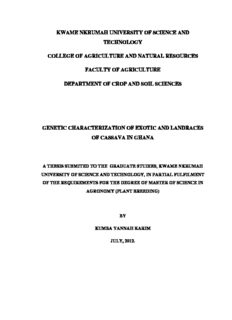
KUMBA YANNAH KARIM PDF
Preview KUMBA YANNAH KARIM
KWAME NKRUMAH UNIVERSITY OF SCIENCE AND TECHNOLOGY COLLEGE OF AGRICULTURE AND NATURAL RESOURCES FACULTY OF AGRICULTURE DEPARTMENT OF CROP AND SOIL SCIENCES GENETIC CHARACTERIZATION OF EXOTIC AND LANDRACES OF CASSAVA IN GHANA A THESIS SUBMITED TO THE GRADUATE STUDIES, KWAME NKRUMAH UNIVERSITY OF SCIENCE AND TECHNOLOGY, IN PARTIAL FULFILMENT OF THE REQUIREMENTS FOR THE DEGREE OF MASTER OF SCIENCE IN AGRONOMY (PLANT BREEDING) BY KUMBA YANNAH KARIM JULY, 2012. DECLARATION I hereby declare that this work is a direct result of my original field and laboratory research undertakings and are supported by cited references in relation to other previous and similar work performed, and therefore this thesis has not been presented anywhere for a degree. Kumba Yannah Karim ………………………… ………………… (Student) Signature Date Prof. Richard Akromah …………………………… ……………… … (Supervisor) Signature Data Dr. Joe Manu-Aduening ………………………… ………………... (Associate Supervisor) Signature Data Certified by: Head of Department ………………………….. ……………… (Dr. Joseph Sarkodie-Addo) Signature Data DEDICATION I make this special dedication to my parents, Mr. Henry Karim and mother Mrs. Fatmata Karim. This is in remembrance of their numerous financial sacrifices, prayers and moral support to ensure the realization of my academic achievements. ACKNOWLEDGEMENTS I wish to thank the Almighty God for his protection throughout the period of the research work. I wish also to express my sincere thanks to my supervisors: Prof. Richard Akromah (Dean Faculty of Agriculture) and Dr. Joe Manu-Aduening (Crops Research Institute, Kumasi Ghana) for their invaluable comments, skillful supervision and materials contributions which enabled me to complete this research work successfully. My sincere thanks and appreciation also go to all the Staff of the Biotechnology laboratory at CRI for their assistance in my molecular work and Alexander Wireko Kena for his support and encouragement. May God bless them all. My profound gratitude goes to the Alliance for Green Revolution in Africa (AGRA) for offering me the scholarship to undertake the studies in the Science of Plant Breeding and Sierra Leone Agricultural Research Institute (SLARI) for their administrative arrangements and financial/support to undertake the Masters programme at the Kwame Nkrumah University of Science and Technology, Ghana. Lastly, I wish to express my sincere thanks to my sisters and my best friend, Alimamy Edward Kargbo, for their prayers and inspiration towards achieving this goal. To God be the glory, honour and power forever more, Amen! ABSTRACT Cassava cultivars grown in Ghana are often misrepresented due to improper characterization of the genetic materials available. The genetic diversity of 45 accessions which consist of 24 exotic and 21 landraces (selected as a core of 150 cassava accessions) collected from Crops Research Institute of Ghana were assessed and characterized using agro-morphological and molecular means. Both quantitative and qualitative traits such as plant height, angle at first branching, canopy spread, petiole length, root yield, dry matter content, root shape, petiole colour, and pubescence on apical leaves were used to assess their variability for phenotypic characterization. Genomic DNA of the accessions were extracted and used as template for Polymerase Chain Reaction (PCR) amplification involving nine Simple Sequence Repeat (SSR) markers. The recorded gel bands as well as the agro-morphological traits were subjected to cluster analysis and development of dendrogram to show the corresponding similarity coefficients. Agro-morphological characterization grouped 2 accessions into cluster A, whilst 43 accessions were grouped in cluster B. Molecular characterization also grouped 16 accessions in cluster A and 29 in cluster B. Overall, both molecular and agro-morphological characteristics put 3 accessions in cluster A and 42 in cluster B. The genotype identification showed that, the phenotypic characters have a similarity coefficient range of 0.80%-1.00% whilst the molecular also had a wider coefficient range of 0.2-1.0%. These features showed the extent of diversity present in the accession evaluated and served as a basis for efficient management and utilization of germplasm in breeding programme. Therefore, the application of morphological descriptors in characterization of germplasm should be backed by the use of molecular markers. TABLE OF CONTENTS Title Page DECLARATION………………………………………………………………………….I DEDICATION……………………………………………………………………………II ACKNOWLEDGEMENT……………………………………………………………….III ABSTRACT…………………………………………………………………………......IV TABLE OF CONTENTS……………………………………………………………........V LIST OF TABLES……………………………………………………………………….X LIST OF FIGURES……………………………………………………………………..XI LIST OF APENDICES………………………………………………………………....XII LIST OF ABBREVIATION…………………………………………………………...XV CHAPTER 1 1.0 INTRODUCTION…………………………………………………………………….1 CHAPTER 2 2.0 LITERATURE REVIEW……………………………………………………………. 5 2.1 Importance of cassava…………………………………………………………5 2.2 Genetic composition of cassava……………………………………………….6 2.3Cassava plant morphology and growth………………………………………...7 2.4 Leaf production………………………………………………………………..8 2.5 Flowering……………………………………………………………………...8 2.6 Breeding of cassava…………………………………………………………...9 2.7 Germplasm conservation and maintenance………………………………….10 2.8 Gains from genetic diversity in cassava improvement………………………11 2.9 Classification of cassava……………………………………………………..12 2.10 Agro-botanical characterization…………………………………………….13 2.11 Importance of characterization……………………………………………..16 2.12 DNA-based molecular techniques………………………………………….17 2.13 Random Amplified Polymorphic DNA (RAPD)………………………….18 2.14 Amplified Fragment Length Polymorphism (AFLP)…………………........19 2.15 Microsatellites……………………………………………………………...19 CHAPTER 3 3.0 MATERIALS AND METHODS……………………………………………………….21 3.1 Location of study……………………………………………………………..21 3.2 Source of cassava accession…………………………………………………..21 3.3 Land preparation………………………………………………………………22 3.4Experimental Design and plot layout………………………………………22 3.5 Planting and culture practices………………………………………………..22 3.6 Molecular Diversity Assessment……………………………………………...24 3.6.1 DNA extraction and purification…………………………………24 3.6.2 PCR Amplification of SSRs………………………………………...25 3.6.3 Primers………………………………………………………………26 3.6.4 Running of gel ……………………………………………………...27 3.6.5 Sliver Staining……………………………………………………..27 3.7 Data collection……………………………………………………………………….28 3.7.1 Establishment leaf and canopy characteristics…………………28 3.7.2 Diseases assessment…………………………………………...28 3.7.3 Storage root characteristics……………………………………29 3.8 Dry matter………………………………………………………………………...........39 3.9 Scoring of bands from agarose………………………………………………….........29 3.1 Statistical analysis……………………………………………………………………..30 3.11 Framework for characterization of accession………………………………………...30 CHAPTER FOUR 4.0 RESULTS……………………………………………………………………………33 4.1 Core collection………………………………………………………………………33 4.2 Genetic difference in Morpho-agronomic traits……………………………………..35 4.2.1Morpho-agronomic analysis of quantitative traits……………………...35 4.3 Variation in qualitative traits………………………………………………………..37 4.3.1 Root shape………………………………………………………………..37 4.3.2 Petiole colour…………………………………………………………….38 4.3.3Shape of central leaflet…………………………………………………...39 4.3.4 Growth habit on stem…………………………………………………….40 4.3.5 Pubescence on apical leaves…………………………………………......41 4.3.6 Flowering……………………………………………………………......42 4.3.7 Texture of root epidermis…………………………………………..........43 4.3.8 Colour of apical leaves…………………………………………………...44 4.4 Severity of disease……………………………………………………………………45 4.4.1 Cassava Bacteria Blight (CBB)…………………………………………...45 4.4.2 Cassava Anthracnose Disease (CAD)…………………………………….46 4.4.3 Africa Cassava Mosaic Disease (ACMD)……………………………......47 4.5Morphological characterization using dendrogram…………………………………48 4.6 Genetic diversity analysis of SSR markers………………………………………….50 4.7Grouping of morphological and molecular markers………………………………..55 CHAPTER 5 5.0 Discussion……………………………………………………………………………57 5.1Morpho-agronomic variation in quantitative and qualitative traits…………………57 5.2Genetic variation by SSRs markers………………………………………………….60 5.3Characterization of genotypes based on their phenotypic and molecular character …………………………………………………………………………………63 CHAPTER 6 CONCLUSION …………………………………………………………………………64 RECOMMENDATION…………………………………………………………………65 REFERENCES………………………………………………………………………….66 APPENDICES………………………………………………………………………….85
Description: